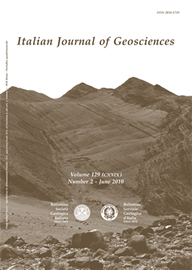
Early Pleistocene rocky coasts (Orvieto area, Western Umbria, Central Italy): facies analysis and sedimentation models
Roberto Bizzarri(*)
(*) Via A. Capitini, 8 - 06055 Marsciano (PG) - roberto.bizzarri@libero.it
DOI: https://doi.org/10.3301/IJG.2010.02
Volume: 129 (2010) f.2
Pages: 251-268
Abstract
Early Pleistocene (Santernian: MNN 19b-c Nannofossil Zones) coastal marine deposits related to rocky coast evolution have been described in a wide area near Orvieto (Umbria, Central Italy). Sediments range from boulders and blocks, to rounded pebbles and cobbles, to sands, silts and clays. Sedimentological analysis enables description of five main facies associations leading to identification of sea-cliff toe, beachface, upper and lower shoreface and offshore environments. The succession documents regressive-transgressive cycles. Lateral facies variations due to the paleocoast morphology have also been noted, and some sedimentation models are here proposed.
The rocky coast evolution can be interpreted in relation to a «cliff cycle»: during transgressions, the cliff is directly exposed to wave energy and production of boulders and blocks is promoted, as well as the reworking and deposition of rounded to flattened cobbles and pebbles on the beachface. At the same time, a seaward sandy sedimentation takes place. Regressive phases, and cliff erosion itself, cause the seaward shift of coastal systems, until the cliff becomes confined to the backshore. During sea-level falls, only reworking of previous deposits can occur. This model is suitable for high energy zones near promontories, but seems inadequate to explain sedimentation on lower energy zones (e.g.: embayments), where other factors, as coastal slope and bay's size, play a key role in determinate facies distribution. The main differences in facies organization occur during regression, and specific sedimentation models are proposed.
Protected areas behind the promontories show a thin fringe of cliff talus and «coarse clastic beachface» and a wider sand/calcarenitic shoreface. During transgression, facies pattern resemble the high energy zones, with a gravel beachface here broader than cliff talus and a sharper transition to the shoreface. During regression, both beachface gravel and upper shoreface clinostratified sand shift seaward, above the sub-horizontal lower shoreface facies. Sheltered bays with gravel beaches, organized on shore-parallel «facies belts», locally occur. The upper beachface may here persist longer during regression, and better organization occurs in the swash zone and foreshore, represented by alternations of «imbricate» and «infill» zones, and «infill» and «outer frame» zones respectively. Conversely, during transgression the «imbricate» zone is also replaced by a «coarse clastic beachface». During both transgressive and regressive phases, offshore silty clay sedimentation shows no modification.
Keywords
Get Full Text